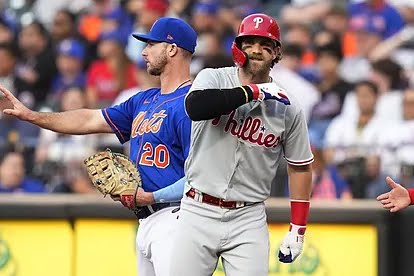
Bryce Harper’s contract with the Philadelphia Phillies has profound implications for Pete Alonso and his future as a player. Signed to a 13-year, $330 million deal in 2019, Harper’s contract is the largest in Phillies history and set a precedent in terms of financial commitment to a single player. While Harper’s deal has solidified his status as a cornerstone of the Phillies’ roster, it has also created a challenging environment for other players, especially sluggers like Alonso, who are looking to secure massive contracts themselves.
First, let’s consider the timing. Alonso is a power-hitting first baseman for the New York Mets, entering the prime years of his career. As one of the most prolific home run hitters in Major League Baseball, Alonso has made a name for himself with his consistent ability to hit bombs, win Home Run Derbies, and provide leadership to the Mets. Naturally, as his arbitration years near, Alonso is going to want a contract that reflects his value as one of the premier sluggers in the league. But here’s where Harper’s contract plays a role.
Harper’s deal is often cited as one of the major benchmarks in free-agent contracts. It is a $330 million contract, but it is important to note that the average annual value (AAV) is $25.4 million. That’s a hefty sum for a player of Harper’s caliber, especially considering the years and commitment involved. However, the current baseball market, influenced by Harper’s deal, has created an expectation that elite power hitters like Alonso will also be in line for massive, long-term contracts, which could set a tough precedent for his negotiations.
For Alonso, one of the major barriers is that he plays a position—first base—that, despite the importance of power hitters, does not have the same level of positional value as outfielders or shortstops. The market for first basemen is often lower than that for star outfielders or middle infielders, which limits Alonso’s potential earnings compared to Harper’s. Given that Harper’s contract was record-breaking for an outfielder, there is a lingering expectation that Alonso could command a similarly massive deal. However, teams are increasingly wary of long-term contracts for first basemen due to concerns about their aging curve, which may hinder Alonso from securing the same kind of payday Harper got.
The contract environment also impacts how teams view their financial commitments. The Mets, under the ownership of Steve Cohen, have the financial resources to compete for big contracts, but that doesn’t mean they are willing to allocate the same type of massive investment seen with Harper’s deal. With the potential for inflation in player salaries and changes in collective bargaining agreements, Alonso’s representatives must navigate these tricky waters. A lucrative, long-term deal akin to Harper’s may not be realistic in today’s market for first basemen, thus impacting Alonso’s earning potential.
In conclusion, Bryce Harper’s contract is a double-edged sword for Pete Alonso. While it sets a high standard for star players, it also highlights the financial constraints and positional biases that could limit Alonso’s earning potential. As Alonso nears free agency, he faces the challenge of securing a deal that acknowledges his elite power-hitting abilities while contending with the reality that his position may not command the same financial windfall that Harper’s outfield status did.
Leave a Reply